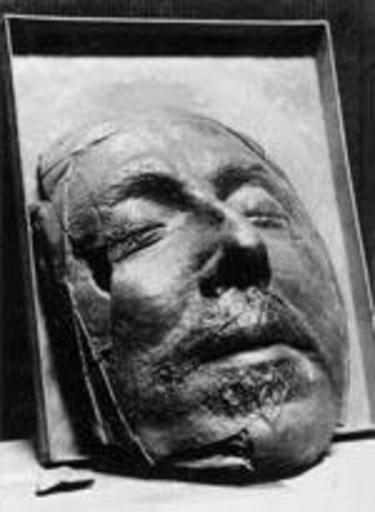MAKE A MEME
View Large Image

| View Original: | Death_mask_of_Oliver_Cromwell.jpg (150x205) | |||
| Download: | Original | Medium | Small | Thumb |
| Courtesy of: | www.flickr.com | More Like This | ||
| Keywords: blackandwhite monochrome black and white Oliver Cromwell (born April 25, 1599 Old Style, died September 3, 1658 Old Style) was an English military and political leader best known for his involvement in making England into a republican Commonwealth and for his later role as Lord Protector of England, Scotland, and Ireland. He was one of the commanders of the New Model Army which defeated the royalists in the English Civil War. After the execution of King Charles I in 1649, Cromwell dominated the short-lived Commonwealth of England, conquered Ireland and Scotland, and ruled as Lord Protector from 1653 until his death in 1658. Cromwell was born into the ranks of the middle gentry, and remained relatively obscure for the first 40 years of his life. At times his lifestyle resembled that of a yeoman farmer until his finances were boosted thanks to an inheritance from his uncle. After undergoing a religious conversion during the same decade, he made an Independent style of Puritanism a core tenet of his life. Cromwell was elected Member of Parliament (MP) for Cambridge in the Short (1640) and Long (1640-49) Parliaments, and later entered the English Civil War on the side of the "Roundheads" or Parliamentarians. An effective soldier (nicknamed "Old Ironsides"), he rose from leading a single cavalry troop to command of the entire army. Cromwell was the third person to sign Charles I's death warrant in 1649 and was an MP in the Rump Parliament (1649-1653), being chosen by the Rump to take command of the English campaign in Ireland during 1649-50. He then led a campaign against the Scottish army between 1650-51. On April 20, 1653 he dismissed the Rump Parliament by force, setting up a short-lived nominated assembly known as the Barebones Parliament before being made Lord Protector of England, Scotland, and Ireland on 16 December 1653 until his death. He was buried in Westminster Abbey, but when the Royalists returned to power in 1660, his corpse was dug up, hung in chains, and beheaded. Cromwell has been a very controversial figure in the history of the British Isles – a regicidal dictator to some historians (such as David Hume and Christopher Hill) and a hero of liberty to others (such as Thomas Carlyle and Samuel Rawson Gardiner). In Britain he was elected as one of the Top 10 Britons of all time in a 2002 BBC poll.[1] His measures against Irish Catholics have been characterized by some historians as genocidal or near-genocidal,[2] and in Ireland itself he is widely hated. Oliver Cromwell (born April 25, 1599 Old Style, died September 3, 1658 Old Style) was an English military and political leader best known for his involvement in making England into a republican Commonwealth and for his later role as Lord Protector of England, Scotland, and Ireland. He was one of the commanders of the New Model Army which defeated the royalists in the English Civil War. After the execution of King Charles I in 1649, Cromwell dominated the short-lived Commonwealth of England, conquered Ireland and Scotland, and ruled as Lord Protector from 1653 until his death in 1658. Cromwell was born into the ranks of the middle gentry, and remained relatively obscure for the first 40 years of his life. At times his lifestyle resembled that of a yeoman farmer until his finances were boosted thanks to an inheritance from his uncle. After undergoing a religious conversion during the same decade, he made an Independent style of Puritanism a core tenet of his life. Cromwell was elected Member of Parliament (MP) for Cambridge in the Short (1640) and Long (1640-49) Parliaments, and later entered the English Civil War on the side of the "Roundheads" or Parliamentarians. An effective soldier (nicknamed "Old Ironsides"), he rose from leading a single cavalry troop to command of the entire army. Cromwell was the third person to sign Charles I's death warrant in 1649 and was an MP in the Rump Parliament (1649-1653), being chosen by the Rump to take command of the English campaign in Ireland during 1649-50. He then led a campaign against the Scottish army between 1650-51. On April 20, 1653 he dismissed the Rump Parliament by force, setting up a short-lived nominated assembly known as the Barebones Parliament before being made Lord Protector of England, Scotland, and Ireland on 16 December 1653 until his death. He was buried in Westminster Abbey, but when the Royalists returned to power in 1660, his corpse was dug up, hung in chains, and beheaded. Cromwell has been a very controversial figure in the history of the British Isles – a regicidal dictator to some historians (such as David Hume and Christopher Hill) and a hero of liberty to others (such as Thomas Carlyle and Samuel Rawson Gardiner). In Britain he was elected as one of the Top 10 Britons of all time in a 2002 BBC poll.[1] His measures against Irish Catholics have been characterized by some historians as genocidal or near-genocidal,[2] and in Ireland itself he is widely hated. | ||||